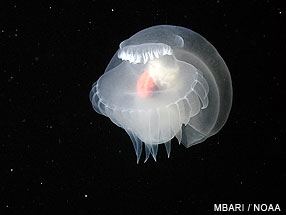Turning the Tide on Deep Sea Destruction
The deep sea is an extreme and unforgiving environment, so it may be surprising to learn that it is home to an estimated 10 million distinct species, rivaling the biodiversity of some of the world's richest tropical rainforests.
This dark region begins around 200 meters (218 yards) below the surface of the ocean, where most light cannot penetrate, and ends at the bottom of the ocean, at an average depth of nearly 4.3 kilometers (2.6 miles). Coral reefs up to 8,500 years in age, sharks and fish unchanged since the age of the dinosaurs, and many organisms that have yet to be documented by science thrive in these depths.
But for all the wonders of the deep, these ecosystems are under serious threat. This is especially true for those that are found in the international waters of the high seas, beyond any country's national jurisdiction. Recent advances in technology, including stronger engines, bigger nets, advanced navigational tools and fish-finding electronics, have enabled fishing vessels to travel further and cast their nets deeper than ever before, scouring the deep sea's undiscovered mountain peaks, canyons and seabed. As a result, fleets roam the high seas of the world's oceans, destroying seascapes that have taken millennia to form in search of a few types of fish to sell at restaurants across Europe, Japan and North America. But deep-sea fishing is expensive, and in many instances, taxpayer money in the form of subsidies props up this industry.
Read More
To truly convey what's at stake in these unique deep-sea ecosystems, the Pew Environment Group recently put together a short video featuring many visually-stunning images of deep-sea life, as well as the barren aftermath left by high-seas bottom trawlers that have dragged their heavy nets and weights across the ocean floor. Scientists attest that this fishing method is the single most destructive fishing activity currently occurring on the high seas.
Since 2004, the international community, through the United Nations (U.N.) General Assembly, has called on fishing countries and regional fisheries management organizations (RFMOs) to urgently act to protect deep-sea life. Beginning in 2006, U.N. resolutions that outlined a plan to safeguard this fragile biodiversity passed. Many governments supported an outright moratorium on high-seas bottom trawling, but countries operating deep-sea vessels instead promised to take action to make fisheries more sustainable and protect vulnerable marine ecosystems. Ultimately, they agreed to conduct a formal assessment after a few years to determine how well the resolutions had been implemented.
 From September 15-16, the United Nations held a workshop as part of its formal review of deep-sea conservation. It was there that fishing countries and RFMOs highlighted the steps they had taken to comply with the resolutions. At the U.N. meeting, nongovernmental organizations pointed out the significant gaps in the resolutions' implementation, particularly in the Indian and Pacific Oceans. World-renowned scientists also maintained that urgent action was still needed to protect these vulnerable ecosystems. Perhaps, the lone bright spot in the assessment was recognition of the successful adoption of several measures to safeguard one of the harshest ocean areas in the world—Antarctica's Southern Ocean.
From September 15-16, the United Nations held a workshop as part of its formal review of deep-sea conservation. It was there that fishing countries and RFMOs highlighted the steps they had taken to comply with the resolutions. At the U.N. meeting, nongovernmental organizations pointed out the significant gaps in the resolutions' implementation, particularly in the Indian and Pacific Oceans. World-renowned scientists also maintained that urgent action was still needed to protect these vulnerable ecosystems. Perhaps, the lone bright spot in the assessment was recognition of the successful adoption of several measures to safeguard one of the harshest ocean areas in the world—Antarctica's Southern Ocean.
Hopefully, the U.N. delegates listened closely to the scientists who made their concerns clear: the cumulative impacts of continued bottom fishing on these incredibly sensitive deep-sea systems are having devastating effects.
The U.N. will meet again on November 11 to decide on next steps and work towards shaping another deep-sea conservation resolution to submit to the General Assembly. In the meantime, the clock is ticking for high-seas fishing countries to fully comply with measures to which they have already agreed. While discussions on how to safeguard these vulnerable marine ecosystems have been going on for nearly ten years, action is needed to protect the deep sea now.











